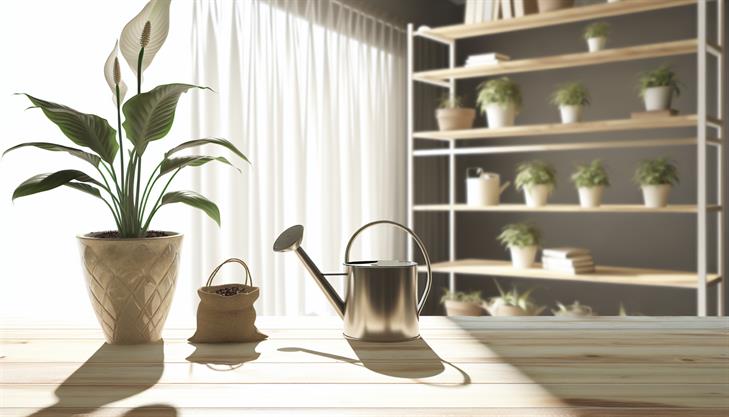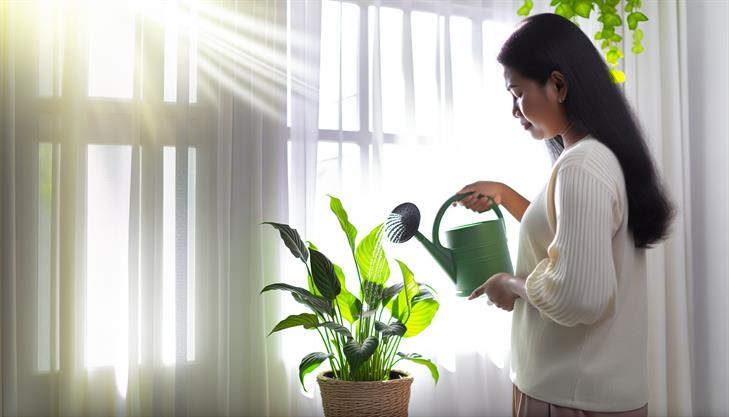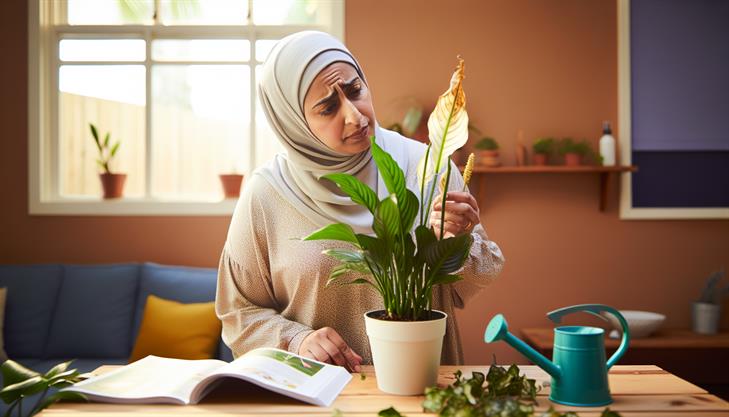Imagine walking into your living space amidst the hustle and bustle of life, only to be greeted by a serene, lush oasis that promises tranquility and a breath of fresh air. That’s the magic a peace lily can bring into your home. With its striking, glossy leaves and elegant white blooms, the peace lily is more than just a beautiful houseplant; it’s a symbol of calm and elegance. But, as with any plant, it requires a touch of love and proper care to truly thrive. In an age where creating green, soothing indoor environments has proven benefits for mental health and air quality, understanding how to nurture a peace lily is essential. This guide is your go-to resource for transforming your living space into a thriving sanctuary. With detailed tips and expert insights, you’ll learn everything you need to know about keeping your peace lily healthy and vibrant, ensuring it remains a cherished part of your indoor garden. Dive in and discover the secrets to cultivating a plant that not only beautifies your home but also purifies the air you breathe.
Getting Started with Indoor Peace Lily Care
Peace lilies are popular indoor plants known for their glossy leaves and elegant white blooms, making them a favorite choice for many plant enthusiasts looking to add a touch of serenity to their homes. Learning how to care for a peace lily indoors can ensure that your plant remains healthy and vibrant. Here’s a detailed guide to help you get started.
Choosing the Right Spot
The first step in taking care of your peace lily indoors is selecting the perfect location. Peace lilies thrive in indirect sunlight, so choose a spot that receives bright, filtered light. Direct sunlight can scorch the leaves, while too little light can prevent blooming. A north or east-facing window is ideal.
Watering Guidelines
Peace lilies are relatively low-maintenance when it comes to watering. To determine when to water, check the top inch of soil; if it feels dry, it’s time to water. Overwatering can lead to root rot, so ensure that your plant pot has drainage holes to prevent water accumulation. When watering, use room-temperature, filtered water if possible, as peace lilies are sensitive to chemicals like fluoride which are often found in tap water.
Humidity and Temperature Needs
Peace lilies flourish in high humidity and temperatures ranging from 65 to 85 degrees Fahrenheit (18 to 29 degrees Celsius). To boost humidity, consider placing a humidifier nearby or setting the pot on a tray filled with water and pebbles. Regular misting can also help, especially during the dry winter months.
Feeding Your Peace Lily
Fertilizing is necessary but should be done sparingly. Use a balanced, water-soluble houseplant fertilizer every 6-8 weeks during the growing season (spring and summer). Avoid fertilizing in the fall and winter when the plant’s growth naturally slows down.
Repotting Tips
Repotting your peace lily every 1-2 years promotes healthy growth. Signs that your plant needs repotting include roots growing through the drainage holes or a noticeable slowdown in growth. Choose a pot one size larger than the current one and use a well-draining potting mix.
Dealing with Common Issues
- Yellow Leaves: This often indicates overwatering. Adjust your watering schedule accordingly.
- Brown Leaf Tips: Can be caused by low humidity, exposure to direct sunlight, or water with high chlorine content. Increase humidity and try using distilled water.
- Wilting: Typically, a sign of underwatering. A thorough watering should revitalize the plant.
Regular Maintenance
To keep your peace lily looking its best, remove any dead or yellow leaves, prune spent blooms, and occasionally clean the leaves with a damp cloth to remove dust that can impede photosynthesis.
By following these steps on how to care for a peace lily indoors, you’ll ensure your plant thrives, enhancing your living space with its lush foliage and graceful flowers. With proper care, peace lilies can be a wonderful addition to your home, bringing not only beauty but also improving indoor air quality.
Essential Watering and Light Requirements
Peace lilies, known for their elegant white blooms and dark green leaves, are popular indoor plants due to their ability to thrive with minimal care. Understanding the essential watering and light conditions can ensure your peace lily remains healthy and vibrant.
1. Optimal Watering Practices:
Watering is crucial in caring for a peace lily indoors. These plants prefer consistently moist soil but can suffer from overwatering. Here’s how to water them effectively:
- Check Soil Moisture: Before watering, check the soil by inserting your finger about an inch deep. If it feels dry, it’s time to water.
- Watering Schedule: Generally, peace lilies need watering about once a week. However, adjustments might be needed depending on factors like humidity and pot size.
- Even Coverage: Water the plant evenly to saturate the roots, allowing the excess to drain. Avoid letting the plant sit in standing water as this can lead to root rot.
- Humidity Needs: Since peace lilies are tropical, they thrive in higher humidity. Consider misting the leaves occasionally or placing the pot on a tray filled with pebbles and water.
When considering how to care for a peace lily indoors, proper lighting is crucial for their growth and flowering:
- Indirect Light: Peace lilies do best in bright, indirect sunlight. Exposure to direct sunlight can scorch the leaves, causing them to brown.
- Low Light Tolerance: While they can tolerate low light conditions, flowering may be reduced. If possible, place them near a north or east-facing window.
- Artificial Lighting: If your space lacks natural light, peace lilies can adapt to fluorescent light, making them ideal for office environments.
Common Issues and Solutions:
- Drooping Leaves: Often a sign of underwatering, but occasionally results from overwatering. Evaluate the soil conditions to adjust appropriately.
- Yellow Leaves: This may indicate overwatering. Ensure your pot has good drainage to prevent waterlogged soil.
- Dusty Leaves: Clean the leaves gently with a damp cloth to allow the plant to photosynthesize efficiently.
Additional Tips:
- Potting and Soil: Use a well-draining potting mix and ensure the pot has drainage holes. Repotting every couple of years can refresh the soil and promote growth.
- Fertilization: Feed peace lilies with a balanced, water-soluble fertilizer every 6-8 weeks during the growing season (spring and summer).
By paying attention to these key aspects of watering and lighting, you can enjoy a lush, healthy peace lily that enhances your indoor space. Regular observation and adjustments in care will accommodate your plant’s specific needs, ensuring it flourishes under your watchful eye.
Tips for Maintaining Ideal Humidity and Temperature
To care for a peace lily indoors, it’s essential to create an environment that mimics its natural habitat, ensuring the plant thrives in your home. Here’s a step-by-step guide to help you maintain ideal humidity and temperature for your peace lily, along with additional tips for successful indoor care:
1. Finding the Right Spot
Begin by choosing the perfect location. Peace lilies prefer indirect, bright light. Direct sunlight can scorch their leaves, while too little light can hinder growth. A location near a north or west-facing window often works best. If natural light is insufficient, consider using a grow light to supplement.
2. Temperature Considerations
Peace lilies thrive in temperatures between 65°F to 85°F (18°C to 30°C). Avoid placing them near drafty windows or heating vents that may subject them to temperature extremes. Maintaining a stable indoor climate will help your peace lily flourish.
3. Humidity Levels
Peace lilies are native to tropical regions, so they appreciate higher humidity. Aim for a humidity level of 50% or higher. You can increase humidity by:
- Placing a tray of water with pebbles beneath the pot (ensure the pot sits on the pebbles, not directly in the water).
- Using a room humidifier.
- Grouping it with other plants to create a micro-habitat.
- Misting the leaves with water occasionally, especially during the drier months.
4. Watering Your Peace Lily
Knowing how to water a peace lily is crucial. The soil should be kept moist but not soggy. Allow the top inch of soil to dry out between waterings to prevent overwatering, which can lead to root rot. During the winter months, you can reduce watering frequency, while increasing it in the summer.
5. Fertilizing
Fertilize your peace lily with a balanced houseplant fertilizer every 6-8 weeks during spring and summer. Avoid over-fertilizing, as it can cause browning of the leaf tips.
6. Pruning Tips
Regularly remove yellowing or dead leaves to keep your plant healthy and promote new growth. Trim spent blooms at the base with clean scissors to encourage the development of new flowers.
7. Common Issues and Solutions
- Brown Tips: Often caused by low humidity or over-fertilization. Increase humidity levels or reduce fertilizer use.
- Yellow Leaves: Could be a sign of overwatering. Ensure proper drainage and adjust your watering schedule.
- Pests: Check for common pests like spider mites. Treat with insecticidal soap if necessary and maintain good hygiene around the plant.
8. Repotting
Repot your peace lily every 1-2 years to refresh the soil and give roots more space. Choose a pot that’s one size larger, as peace lilies prefer slightly crowded roots.
9. Final Advice
Regularly dust the leaves with a soft, damp cloth to keep them clean and allow for maximum photosynthesis. Monitoring your peace lily and adjusting care as needed will ensure it remains a beautiful and thriving part of your indoor garden.
By following these steps, you’ll help your peace lily maintain its ideal conditions, ensuring it stays healthy and continues to grace your home with its lush foliage and striking white flowers.
Troubleshooting Common Peace Lily Problems
Peace lilies, known for their attractive, dark green leaves and striking white blooms, thrive indoors when given the right conditions and care. This guide will help you understand how to care for a peace lily indoors by addressing common issues, giving practical setup tips, and offering additional advice to ensure your plant remains healthy and vibrant.
Ideal Location and Lighting:
Peace lilies prefer indirect sunlight. Place your peace lily in a room with bright, filtered light, but keep it away from direct sun exposure, which can scorch its leaves. If natural light is limited, peace lilies are tolerant of fluorescent lighting, making them perfect for office spaces.
Watering Requirements:
The key to successful peace lily care is proper watering. Water your peace lily when the top inch of soil feels dry. It’s best to water deeply, allowing the excess to drain out of the bottom of the pot. Peace lilies are sensitive to chlorine, so consider using filtered or distilled water. Overwatering is a common problem; soggy soil can lead to root rot.
Temperature and Humidity:
Peace lilies enjoy a warm environment. Maintain an indoor temperature between 65 to 80°F (18 to 27°C) for optimal growth. As tropical plants, they thrive in high humidity. To increase humidity, mist your peace lily’s leaves, place the pot on a tray of pebbles and water, or consider using a humidifier.
Soil and Repotting:
A well-draining potting mix is essential. Use a standard houseplant soil mix and consider adding perlite or orchid bark to improve drainage. Peace lilies generally need repotting every 1-2 years or when they become root-bound. Choose a pot that is 1-2 inches larger in diameter than the current one.
Fertilizing:
Feed your peace lily every 6-8 weeks with a balanced, water-soluble fertilizer during the growing season (spring and summer). Avoid over-fertilizing, as this can lead to brown leaf tips.
Pruning and Cleaning:
Regularly prune dead or yellowing leaves to maintain the plant’s appearance and health. Clean dust off the leaves with a damp cloth to allow the plant to breathe more efficiently.
Common Problems and Solutions:
- Brown Leaf Tips: Often caused by over-fertilization, low humidity, or exposure to tap water with chlorine. Adjust care accordingly.
- Yellow Leaves: Typically a sign of overwatering or inadequate lighting. Check your watering routine and ensure the peace lily receives the right amount of light.
- Lack of Blooms: Might indicate the need for a brighter environment or more nutrients. Assess light conditions and fertilize according to the schedule.
By understanding how to care for a peace lily indoors and implementing these step-by-step practices, you can enjoy the lush foliage and beautiful blooms of this popular houseplant. Adjust your care routine based on the plant’s signals to enhance its health and longevity.
Tools and Accessories for Optimal Peace Lily Growth.
Caring for a peace lily indoors is a rewarding endeavor, as these beautiful plants are known for their elegant white blooms and glossy green foliage. Successfully nurturing your peace lily requires understanding its specific needs and addressing potential challenges. Here’s a step-by-step guide to help you create the perfect environment for your indoor peace lily.
1. Choosing the Right Spot:
To cultivate an indoor peace lily, selecting the appropriate location is crucial. These plants thrive in bright, indirect sunlight. Place your peace lily near a north or east-facing window where it can receive adequate light without direct sunlight, which can scorch the leaves.
2. Proper Potting and Soil:
A well-draining pot is essential for peace lilies, which prefer to stay slightly moist but not waterlogged. Choose a container with drainage holes and use a high-quality potting mix rich in organic matter. A mixture of peat moss, perlite, and bark can provide the right balance of drainage and moisture retention.
3. Watering Routine:
Knowing how to water a peace lily properly is critical to its health. Allow the top inch of soil to dry out before watering. Typically, watering once a week works well, but adjust based on your home’s humidity and temperature. Drooping leaves indicate that it’s time to water, but if this persists after watering, you may need a deeper soak.
4. Maintaining Humidity:
Peace lilies prefer high humidity, mimicking their tropical origins. In dry indoor environments, increase humidity by setting the pot on a pebble tray with water, or by using a humidifier. Mist the leaves occasionally to keep the plant’s environment moist.
5. Temperature Preferences:
Aim to keep your indoor peace lily in a temperature range of 65°F to 85°F (18°C to 29°C). Avoid placing it near cold drafts, heating vents, or air conditioners, as sudden temperature changes can stress the plant.
6. Feeding Your Peace Lily:
Fertilizing is an important component of indoor peace lily care. Feed your plant with a balanced, water-soluble fertilizer every six to eight weeks during the growing season (spring and summer). Avoid over-fertilizing, as this can lead to nutrient burn and damage the plant.
7. Managing Common Issues:
Keep an eye out for common problems, such as pests like aphids or spider mites, which can be managed with insecticidal soap. Brown tips on leaves typically signify overwatering or low humidity; adjust your care routine accordingly. Yellowing leaves may indicate a need for more light or an issue with drainage.
8. Regular Cleaning and Pruning:
Wiping the leaves gently with a damp cloth will remove dust and allow the plant to photosynthesize efficiently. Prune away any spent blooms or yellowing leaves to encourage healthy growth.
9. Repotting when Needed:
A peace lily grows best when slightly root-bound, but it will require repotting every 1-2 years. Choose a pot one size larger when you notice roots are crowded or growing out of the drainage holes.
Keeping these guidelines in mind forms the basis of how to care for a peace lily indoors effectively. By paying attention to light, water, and humidity, you can ensure that your peace lily remains healthy and vibrant all year round. Remember, a happy peace lily actively contributes to improving indoor air quality, adding both aesthetic and health benefits to your living space.
In conclusion, caring for a peace lily indoors is a rewarding endeavor that combines the joy of nurturing a living plant with the benefits of purifying your home’s air. To summarize, it’s essential to provide your peace lily with indirect light and maintain a consistent watering schedule, ensuring the soil is moist but not waterlogged. Regularly clean the leaves to maximize their ability to filter air, and don’t forget to fertilize occasionally during the growing season for optimal growth. By keeping an eye on signs of distress, like yellowing leaves, you can adjust care routines quickly to ensure your peace lily thrives.
Now that you’re equipped with the knowledge to care for your peace lily, I encourage you to put these steps into practice and observe the positive impact this beautiful plant can have in your living space. As a final tip, consider rotating your peace lily by a quarter turn every time you water. This practice promotes even growth and helps the plant maintain its elegant appearance. Happy gardening!


